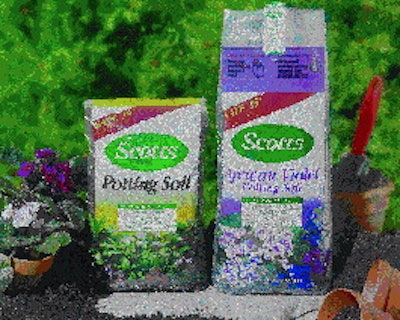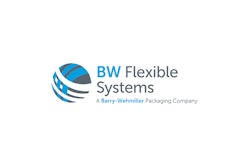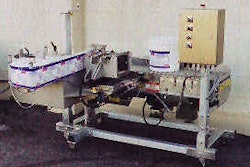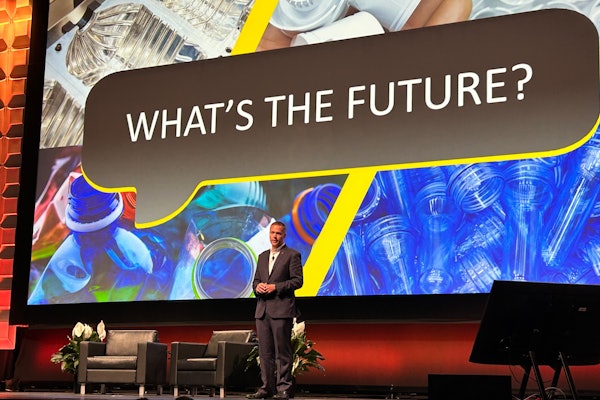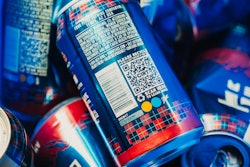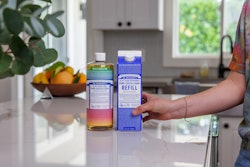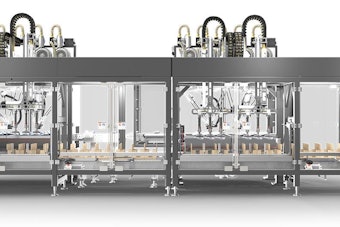Some people say that consumer marketing is like trying to shoot the moving ducks in an arcade game with a rifle. Just when you get your timing down, something from the opposite direction gets in your way. That's what it's been like so far as The Scotts Company, Marysville, OH, has geared up to produce 10-qt flat-bottomed plastic bags of its premium potting soils. A year ago, the company was readying a packaging line at Scotts' Imlay City, MI, soil packaging plant. Material substitutions, bag size changes, tooling changes, even the weather conspired against getting the line up and running. Last October, Phase I of the installation began operation after months of disappointment. Imlay City produces and packages soils and peat under the Scotts®, Hyponex® and other brand names. Most of its production is packed into large polyethylene sacks (20 lb and more). Like other companies, Scotts palletizes these sacks flat and stretch wraps them as further protection against the elements. Meanwhile at its Marysville headquarters, Scotts' marketing staff decided to use potting soils as its entry into flat-bottomed bags that could be merchandised either standing on the flat bottom (the preferred way) or flat like conventional bags. In the 10-qt size (roughly 10 lb/bag), the colorfully printed bags were designed to be the package that would finally convince grocery store operators to put soils onto the supermarket shelf. To produce the package, Scotts purchased an Ultima flat bottom bag packaging system from Hayssen (Sheboygan, WI), complete with a volumetric feeding system. Scotts also has now committed to packaging with a costly lamination, 3.5 mils of linear low-density polyethylene/reverse-printed polyester from Union Camp (Wayne, NJ). Thanks to trapping the flexo printing inside the lamination, the graphics are very strong and protected from abrasion. The polyester gives the exterior a glossy look that's in keeping with Scotts' traditional quality image. Currently the 25 3/4" rollstock is printed by the Asheville, NC, plant of Union Camp in nine colors, says Jon Moyer, packaging engineer. The top of the gabletop bag is folded down and a cohesive label from Cal Emblem (Fresno, CA) is affixed so that the consumer can reclose the bag once the tight, brick-style bag has been opened. While product quality and the appearance of the package have been impressive to more traditional markets, Scotts is just now beginning to see orders from supermarkets. The package is already popular with the home centers, garden centers and mass merchandisers that are Scotts' mainstay customer base. But most of the bags sold through these outlets have not been produced on the new line at Imlay City. Scotts has been packaging the product in premade bags at several of its other soil packaging plants around the country. That's how the company can meet the demands of the national retailers like Kmart and Wal-Mart while it keeps overall freight costs down. Stand-up performer There's little question that the flat-bottom, stand-up bag is well-liked by Scott marketers. It's the easiest way to show off Scotts' eye-catching graphics, and it's the easiest package shape for on-shelf merchandising in any kind of outlet. It also offers improvements in secondary packaging, particularly in creating pre-built displays. On Scotts' current bag, the bottom is printed with a line that reads, "Please merchandise this side down." Scotts has already experimented with pre-built point-of-purchase displays. The current version includes the use of corrugated trays to hold 15 standing bags, each surrounded by corrugated cell dividers that bear the weight of the tiers above. To minimize that packaging waste, the company is looking to recyclable/reusable molded plastic trays without any weight-bearing partitions. When proven, the bags themselves would bear the weight of the tiers above. "What's holding us up right now on this program is the evacuation of air from the bag and the folding down of the bag tops," says Steve Ambrozy, project leader for package development for Scotts. "We are working with Hayssen to develop heated probes that will puncture the bag near the gabled top to allow air to escape. The holes in the bag will be cauterized to prevent any further tearing. "We also have a proposal for a machine that will, via vibration, settle the soil in the bag. Another system will capture the top of the bag, make two folds as it presses out trapped air and then apply the cohesive label to hold the top down. This bag will then be a nice tight block that can support weight, like two more tiers of bags." This equipment is part of Ambrozy's "wish lists" for later this year and even farther down the road. That's because the packaging line at Imlay City is still a bit primitive. Two versions of same story There's little doubt that the flat-bottom bag is very popular at Scotts' headquarters. Similarly, there's no doubt that the reverse is true in Imlay City, a Michigan town 30 miles east of Flint. The plant produces a variety of soil products and packages them on three plastic bag machines from Bemis Packaging Services (Minneapolis, MN). Using straight low-density polyethylene film, these lines chug along, feeding bags into automatic or semi-automatic palletizers. When the plant was selected to produce the flat-bottom bag on automated packaging equipment, the crew was probably not excited about a new challenge. The level of enthusiasm further dissipated as attempts to run the machine were sporadic while materials and sizes and tooling all were changed in '94. When the laminated packaging material was finally selected and the Hayssen installation completed in the plant last October, the machine began regular production. The appropriate soil is blended and conveyed to drop into the hopper that feeds the volumetric buckets that meter the product into the bag. If the plant environment was difficult last October, it became a real test during winter. Not only does the equipment have to contend with dirt and dust and other contaminants, but packing room temperatures sometimes fail to get above 40°F during the day, points out Woody Strong, operations manager at Imlay City. This isn't a problem for the soft LDPE packaging materials that run on the bag lines. However, the lamination for the flat-bottom bag becomes brittle in the cold. "Until our plant temperature gets up to 60 degrees or more, we have problems with film breaks," Strong says. Ambrozy says that Scotts' packaging research lab in Marysville has been developing the specs for the material, including preconditioning techniques for cold weather. "Right now, it looks like the converter is asking for conditioning of the rollstock at 65 to 68 degrees F for 48 hours to 72 hours prior to running," he says. Machine operation "We've been operating this machine four or five days a week since last fall," Ambrozy points out. "It's been virtually maintenance-free, except for replacement of film pull-down belts. We've really had no problems with either the mechanical or electronic parts. This is a very user-friendly machine, similar in many ways to our Bemis equipment. So we put together a short training class with Hayssen's help." The electronically-controlled Ultima CMB is similar to a standard Hayssen vertical form/fill/seal machine. However, in addition to making lap, top and bottom seals on the laminated material, the machine also has creasers and tuckers that create the bag sides and the gussets at the bottom and top for the flat bottom and the gable-shaped top. Measuring rollers just ahead of the forming shoulder feed the film over the shoulder while the pulling belts advance the film down the forming tube. This combination minimizes stress on the material and results in better seals. It also permits longer dwell time for stronger seals with heavier multilayer films. The tuckers fold in the gussets more slowly, also reducing stress on the material while producing a better bottom and a better top profile. The bottom seal jaw's one-piece design is said to deliver stronger seals and a better bag bottom appearance. In practice, the bottom is formed and sealed just as the charge of product descends into the bag, so that the fill of product serves somewhat as a sealing platen. A moment later, the top is sealed and cut from the web and the bag drops into the bucket at the base of the machine. A pusher arm then knocks the bag onto an inclined discharge belt. Manual steps now In its current Phase I form, Scotts is using temporary workers to first punch holes near the top of the bag, then to fold down the gabled bag top and apply a cohesive label to hold down the top. Other workers then erect a 200#-test corrugated box and load it with four of the bags of soil. The box is then positioned at the infeed of a Little David box taper from Loveshaw (Long Island City, NY) that seals the box top and bottom. As the box is discharged from the taper, it passes the printhead of a Diagraph (EarthCity/St. Louis, MO) ink-jet printer. On the plain kraft box, the printer identifies the Scotts' potting soil and follows it with a bar code. This permits company warehouses to distinguish between cases of the four separate products: potting soil, soil for African violets, seed starter and potting soil with fertilizer. It's the manual steps between bagging and case sealing-all done in somewhat cramped space-that really "pace" the line at 18 bags/min. Five workers perform these tasks, and a sixth is the machine operator. Beyond the case taper, another worker manually builds pallet loads. Steve Ambrozy proudly shows off blueprints for Phase II and Phase III. The next step, which could be in place by the end of the year, is semi-automated with more conveyor space and the probes to automatically punch the holes into the bag before it leaves the packaging machine. "Although we'd still use workers to press the air out of the bags and apply the cohesive label strips, the main advantage is that the packaging machine would govern the speed of the line, not the workers as now," Ambrozy says. He predicts that output would increase to at least 20 bags/min with one fewer worker. At least one additional worker would be reassigned when and if Phase III is implemented. In the plan, machines perform the air evacuation, the folding down of the bag top and the application of the label. Case forming and packing remain the same, but the line speed is expected to increase to 23 bpm, Ambrozy predicts. In this plan, a special conveyor would have side plates to settle the soil and squeeze the air from bags standing on their bottoms. Then a special head would sense and capture the top of the bag, fold it down in two steps and affix the label to hold it down. This would deliver a tightly packed bag for case or display tray loading. Materials could change Scotts' marketers like the bag appearance with its colorful graphics protected by reverse printing. At the same time, the company recognizes that it may be able to economize a bit on materials. "We're looking to take some material out of the package, so long as we don't sacrifice clarity, strength and gloss," says Moyer. The company has investigated the use of a straight LDPE like it uses on the larger bags. While that could reduce its cold weather problems, it doesn't offer the crystal clarity that lets the product quality show through. "But in a marketplace where costs keep going up, it becomes a more viable alternative," Moyer concedes. However, he also says that the company is challenging converters to develop other sophisticated films that may not be commercially available for another year or two. Today, the Imlay City plant ships pallet loads of Scotts' potting soil to company warehouses mostly in the Northeast. Some customers, like major discounters in the northern states, receive product direct from the plant in full-trailer orders with other products. For the most part, the loads are shipped to company warehouses, where pallets are mixed with pallet loads of other products for shipment to customers. If stand-up, flat-bottomed bags become as popular as Scotts' focus group testing anticipates, it's likely that the work at Imlay City could be reproduced in other company plants so it could ship economically nationwide. "What we're examining for the future is whether this packaging style-flat-bottomed bags-can help us merchandise fertilizers and other products in a manner that retailers and consumers will prefer," Ambrozy says. While the firm evaluates the payback on improvements to the Imlay City line, package developers like Ambrozy are also looking at ways to add a handle to the bag to make it more consumer-friendly. When a company has the kind of brand franchise that Scotts has, don't bet against a handle.
